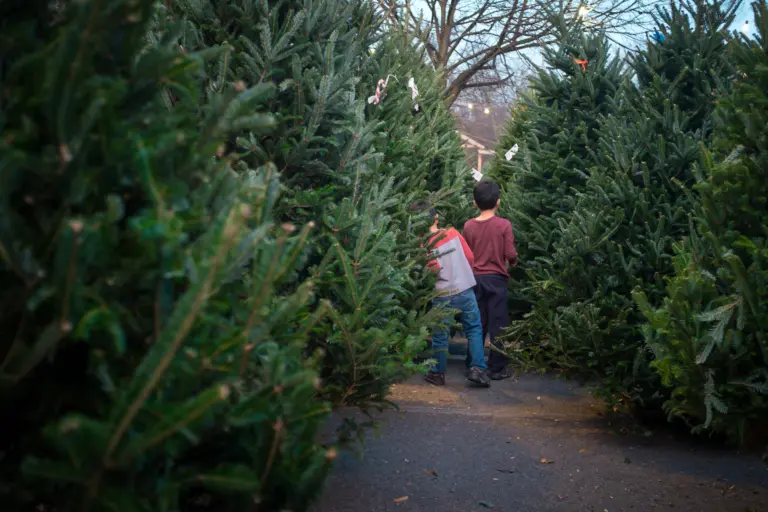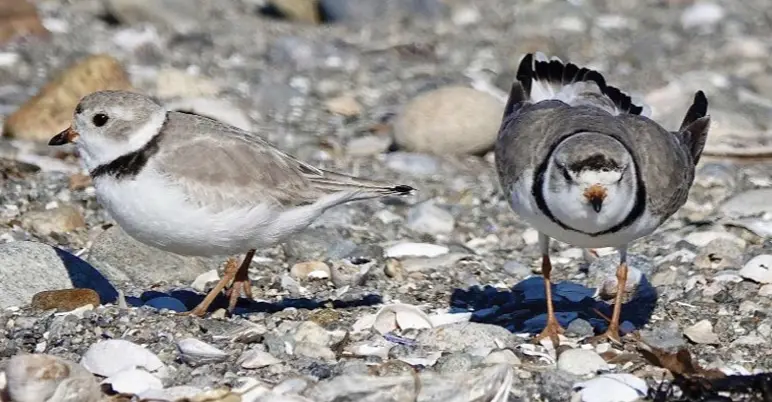
By Frank Gallo
March 11th. Snow from a front the night before has left a light dusting on the beach at Milford Point. A male Piping Plover lands among the seaweed wrack. He’s exhausted from his northward migration; now complete. His winter was spent roaming the sandy beaches on Cuba’s north shore. Now he is on his breeding grounds, and soon it will be time to establish a nesting territory and attract a mate. He is a few days early. Tail winds aided his northward journey. Females won’t arrive for several more days or even weeks;usually in mid to late March into early April. Perhaps he’ll reunite with his mate from last summer. They had a successful nesting. Only time will tell. But first a meal and a little rest. Although the air is chilly, there are still invertebrates nestled within the warmth of the decaying wrack.
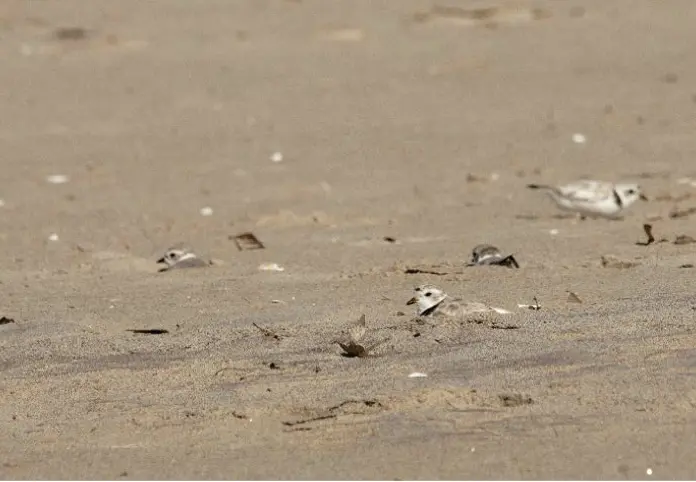
After a much-needed meal, he patrols the beach, assessing the best location for his territory. It looks like the area he used last year is still suitable and no rivals have yet arrived to contest his claim – an advantage of arriving early – but soon they will come.
March 16th. He has successfully driven off two interlopers to retain his prime nesting territory. His past mate has not appeared, but there are other females arriving daily and it’s time to find a partner. He begins by making figure-eight flights above his territory, hoping to attract their attention.
March 19th. Dawn finds him feeding along the wrack line when he hears a familiar plaintive “peep-lo, peep-lo,” from another Piping Plover. It is his past mate flying in from the south, low over the water. She lands near him on the beach and they call to one another softly. Hoping to impress her, he launches into the sky and circles over his territory performing elaborate dips and turns and tilting side to side with deep slow flaps. He then begins goosestepping before her with stiff legs and feet fanned in a ritualistic display to cement their bond.
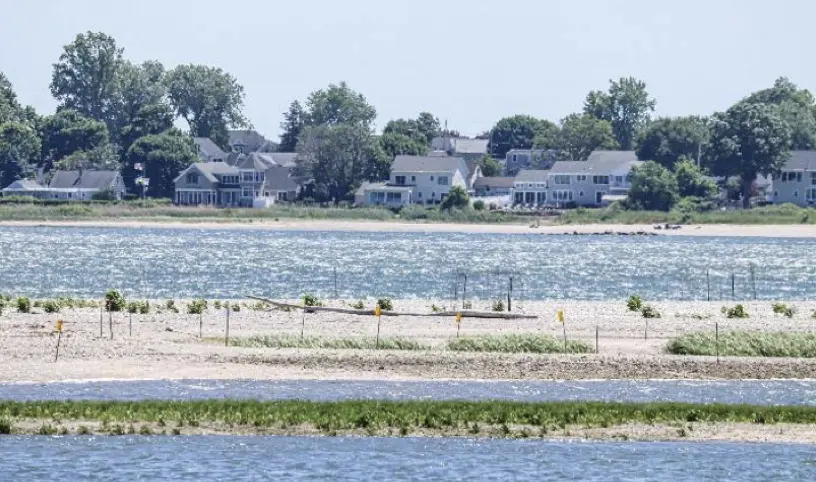
April 5th. Courtship is in full swing. He now walks through his territory making several nest scrapes in the sand using his breast and feet while his mate accompanies him. He continues scraping depressions in the sand for nine more days, adding pebbles and shells to each site with help from his partner, until she chooses her favorite spot (often the site where they have copulated the most). Her choice made, he once again begins goosestepping before her, further cementing their bond. They copulate and will do so many times before her final egg is laid. She will lay 4 eggs over six days, incubating them occasionally. Incubation begins in earnest once the last egg is laid.
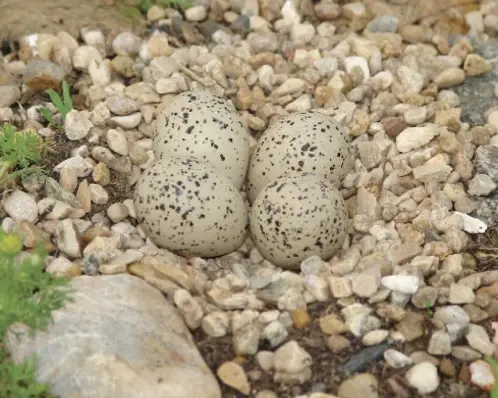
April 21th. Her four speckled eggs resemble beach stones. They will hatch in 27-35 days. Both she and her mate incubate, often remaining still for 30 minutes or more before swapping places to go feed. Their sand-colored bodies are adorned with black bars across their chest and brow, a two-toned orange and black bill, and orange legs. This color pattern breaks up their outline, helping them blend perfectly into their surroundings. This camouflage is their first defense against the many predators which hunt on the open beach. When a predator strays too near the nest, the sitting Piping Plover, like its cousin the Killdeer, races away, calling, hoping to capture the predator’s attention. If the predator doesn’t follow, then more extreme measures are employed – the plover feigns injury by dragging a wing, fanning its rust-colored tail, and flopping about while calling; this usually draws the predator away. Once the predator is deemed sufficiently far from the nest, the seemingly wounded bird miraculously recovers and flies in a wide arc returning to settle back onto the nest.
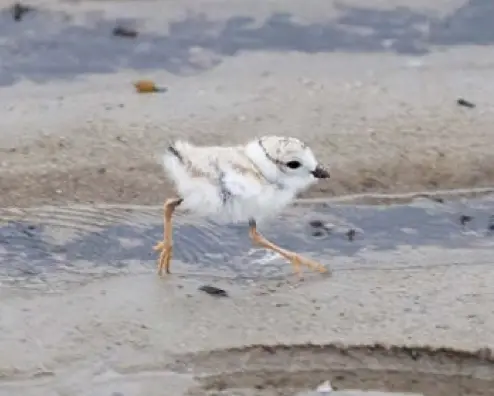
This year, as with last, a crew from Connecticut Audubon has erected string fencing on the beach. This helps keep unsuspecting beach goers from entering the Piping Plover and Least Tern nesting areas and inadvertently stepping on their eggs. Volunteers also placed a wire mesh called an exclosure around the plovers’ nest with a netting top to keep avian and terrestrial predators out. The mesh spacing is wide enough for her and her mate to pass through, but not larger creatures.
May 13. Cracks have formed in the eggshell and “peeping” can be heard from within her eggs. Her babies will hatch soon.
May 15. Her eggs are hatching. One by one they emerge, looking for all the world like speckled cotton balls with feet. It’s not safe to remain in a nest on an open beach. There are too many predators – such as, gulls, crows, ravens, cats, dogs, raccoons, foxes, skunks, and opossums. Within a couple of hours of emerging, they are able to run, and soon will be able to feed, hide, and fend for themselves under their parent’s supervision, although they are still brooded frequently. Instinct sends them into cover when a predator nears. Often the chicks seem to disappear into a shallow depression in the sand, where their speckled body pattern helps them to blend with the stones in their surroundings. They will begin to fly in 24 days and fledge between 30-35 days after hatching.
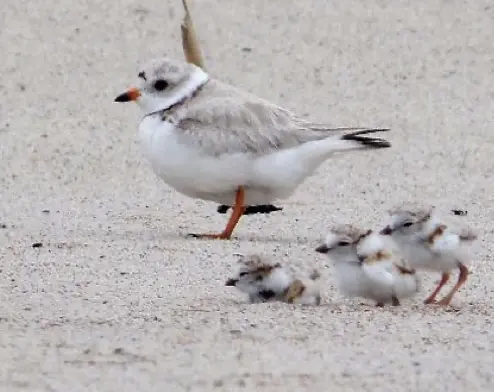
June 15. Three of her four babies have survived to fledge. The fourth was taken by a cat as the chick left the safety of the exclosure.
Piping Plovers generally have only one brood per year, although they may renest after a failed first attempt. Pairs able to nest in April and May can fledge broods by the start of the hurricane season in June. In 2019 there were only 57 pairs breeding in Connecticut. Since then, there has been a slow but steady increase, and in 2024, 83 pairs nested in the state. Conservation programs are paying off. In 2025, Milford Point hosted 21 pairs, a new high, up from 16 pairs in 2024, showing conservation efforts and preserving habitat have positive effects, both for the plovers, and for other sandy-beach dependent species, such as Least Terns and American Oystercatchers.
Piping Plovers are State and Federally designated threatened species. Three of the best places to see them in Connecticut are Milford Point, Milford; Sandy Point, West Haven; and Long Beach in Stratford before it closes to non-residents on Memorial Day. Remember to visit at mid- to low tide to allow beach-room between you and the string fencing that protects the birds from disturbance. Because young plovers hide in depressions such as tire tracks and footprints, and are nearly impossible to see, Piping Plover nesting beaches are closed to vehicular traffic during the breeding season. Walk carefully and try not to disturb feeding plovers, as well as other migrant shorebirds resting and feeding to store fat for their long journeys. Several shorebird species must fly more than 5000 miles between their breeding and wintering grounds. Bar-tailed Godwits, for example, can fly 7,100 miles nonstop between Alaska and New Zealand. Studies have shown that disturbance from humans, dogs, vehicles, etc., can cause them to starve if they are prevented from feeding enroute.
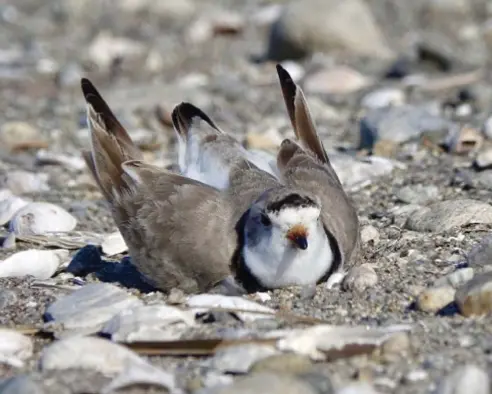
Currently, the Atlantic Coast population of Piping Plovers is fewer than 2250 pairs but increasing, and there are fewer than 6000 pairs throughout the United States. Providing plovers a little space and reducing disturbance increases their chances of a successful nesting season, and their species’ continued survival.
August 15. His mate left last week for parts unknown. He will head back to Cuba tomorrow. With luck, next year, March winds will aid his return to Milford Point to do it all again.
Frank Gallo is the Senior Naturalist at the New Canaan Nature Center, 144 Oenoke Ridge, and the author of Birding in Connecticut, a comprehensive site guide on where, when, and how to find birds in this state. Email: Fgallo@newcanaannature.org. For more on the New Canaan Nature Center, visit newcanaannature.org.

